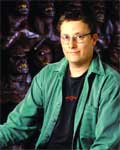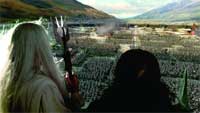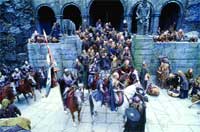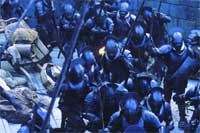
Weta's Richard Taylor on the art of successful special effects: "To constantly back one effect up with a totally different sleight of hand so the audience can never quite grasp what tricks you're playing."
|
NEW YORK - Bad guys. They're the centerpiece of classic epics like Paradise Lost or The Inferno, and they're the key to the blockbuster film franchise based on another classic work of literary fantasy, The Lord of the Rings. Carefully following the 1940s work of author JRR Tolkien, director Peter Jackson's second installment is The Two Towers. Here, the lead bad guys unite; turncoat wizard Saruman and disembodied soul-of-evil Sauron work in concert, each from his own forbiddingly precipitous tower.
They have a lot of help. We see Saruman churning out armies of Orcs and Uruk-Hai, which are quasi-cloned deep in the wizard's foundry, a hellish place fueled by entire forests of harvested trees.
The plan is to devastate the world known as Middle-earth. They want to rid the land of a new, upstart race called men.

Saruman's army: Stephen Regelous's software assigns various distinctive mocap routines to thousands of digital "agents" imparting a sense of independent mobility.
|
Of course, there are also plenty of good guys and antiheroes, and characters of questionable intentions, running around the film. The ring-obsessed Gollum is the creation of actor Andy Serkis and the Weta 3D animation team working with Alias|Wavefront Maya 4.0. Still, without the seemingly endless availability of really good bad guys, the good guys wouldn't have a whole lot to do.
As head of Wellington-based Weta, New Zealander Richard Taylor is known for his fanatical devotion to mastering the exquisitely detailed look of Lord of the Rings. And with the Academy Awards he's started to collect (along with partner Tania Rodger) for practical makeup and for visual effects, Taylor's obviously on the right track. He was in New York last month when Post Magazine caught up with him.
POST: Your job straddles both the practical world of props and prosthetics and the digital world where anything goes. How much fun was it to populate a whole new world for film?
TAYLOR: We had a great amount of enjoyment creating both the evil and good races of Middle-earth, but invariably it's always the evil ones that are the most fun. We had to create a very cohesive world where it felt as though the creatures had manufactured the armor they're wearing. Because Tolkien's writing is so descriptive, because he has written a "bible" that is Middle-earth, it was imperative that we understood that the world [of fans] already had a preconceived idea of what Middle-earth should look like.
A character like Gollum is a good example. The world knows what Gollum should look like. We wanted to bring our own vision to Gollum and wanted to inherit Peter's vision into Gollum, but at all times there was a parameter there that had to be understood and appreciated.

Weta built three different models for the Helm's Deep set, and populated it with real actors and "digital agents."
|
We actually found that [readers' familiarity] actually elevated our design because Tolkien wrote of fantasy but also of heightened reality. And that was a world where the creatures felt extremely real. The Cave Troll had all of the physical attributes of a character from his own world, as did every other character that we'd created.
POST: Describe how Gollum was created?
TAYLOR: Although Gollum was already so carefully mapped out in Tolkien's written words, he still was one of the incredibly subtle complexities. Gollum went through a four-to-five-year design phase, ever changing, ever shifting - we produced over a thousand illustrations and over 100 sculptures of Gollum before we started to commit our ideas to a complete design and scannable maquette. We sculpted Gollum two times life size in the "Leonardo pose" - it was after all this massive preparatory work that we started honing him down to something that we felt could work. We'd committed him through scanning and into the computer and a huge amount of work had already been done in the preparatory building of Gollum and his muscle structure, his fat dynamics, his facial animation - we likened him to a sort of peeled spider monkey. But, only on the arrival of Andy Serkis in New Zealand and the realization that Andy could indeed also play Smeagol, the schizophrenic alter ego of Gollum, did we realize that it was imperative again that Gollum go through another design stage. Only with the deadline looming only nine months away did we throw ourselves wholeheartedly into a whole other design phase that was embraced by all involved to make sure that the essence and physical structures of Andy's face were brought to bear on Gollum.
POST: Would Andy appreciate that?

Gollum: A mingling of acting prowess, motion capture and Maya, the man behind Gollum is being mentioned for Academy Award consideration.
|
TAYLOR: I think he'd appreciate it greatly - because deep in Andy we can find a little bit of Gollum. We were very lucky that Andy brought to bear his immense acting attributes onto that character. We have a saying at Weta - "It's about heartware, not hardware." It's imperative that a character has soul and people have asked often, "Why does Gollum work where possibly other characters haven't captured the heart of the audience?" I really think, in no way taking anything away from the technical attributes of the people involved in the creation of Gollum, ultimately it has to come back to the soul that an actor puts into that character and the technological advancements that have been able to transmit that soul into a digital character onscreen.
POST: The word "massive" makes me think of large armies of subhuman Orcs.
TAYLOR: Absolutely. Peter came to us six or seven years ago and said, "Hey, guys, I'm going to make Lord of the Rings. I'm going to make a film version of these incredible books. And, even if the technology isn't available today, I want that world to replicate Tolkien's imaginings to the highest degree."
One of the very strong icons of Middle-earth are these epic and massive battles. Colossal battles consisting of tens-of-tens-of-thousands of different species going to battle against each other. Up until that point, this sort of epic battle had been attempted using extras but even then to a very modest degree. Only some of the largest movies ever made had ever captured some of the scale of battle work. Spartacus is a great example. To a certain degree the use of digital characters had begun to take a part in this sort of work. But [the digital artists] still had trouble - they felt that they were flocking - they were all following each other's motion and there was no independence. So it was really Peter that sprung the original vision for what ultimately became a program called Massive - a piece of proprietary software created by a young New Zealander called Stephen Regelous.
What he did was create the ability for the computer to think for itself - but not just for itself, for 10,000. Ten-thousand agents acting within the computer could act out these incredible roles drawing on a repertoire of previously captured motion on the motion capture stage.
Peter very cleverly and carefully uses a blend of different techniques so, for the most part, we utilized live performance actors in prosthetics - up to 100 a day on set at any one time acting in the foreground of a shot. Then, masked behind them to a certain degree, are the digital agents. But as the sophistication of the program developed over this past year, the digital artists grew more confident and more capable to do huge, sweeping panoramic views of battle scenery where every single character in there is digitally created - infinitely more so in Two.
The battle of Helm's Deep: we filmed at Helm's Deep for many months with a hundred actors in prosthetics every day, every night, in the rain, up in this dirty, old quarry.
POST: How much of the Helm's Deep set did you construct, rather than model in the computer?
TAYLOR: The whole of it. It was initially built at 1/35 scale as a huge, soundstage-size miniature, then it was built at quarter-scale as a miniature the size of a large quarry, and then it was once again built in two sections at full scale. The whole thing existed as a full piece of construction, and that allowed an amazing freedom for Peter to choreograph these scenes on these environments.
POST: Do the miniatures appear in the film as well as the full scale set?
TAYLOR: They were used heavily in the film. And indeed, the actors were composited into those scenes. But it's the ability to blend different techniques seamlessly. It's like a magician who wouldn't deliver two tricks the same onto the table in case the audience catches on. That's really the art of special effects; to constantly back one effect up with a totally different sleight of hand so the audience can never quite grasp what tricks you're playing.
POST: Until we get the DVD?
TAYLOR: Until bloody slow motion on the DVD! That "stick" button on the DVD is our worst enemy, I'll tell you. You have to make the effects work for the film - not for the ability to freeze it and study it.
I think one of the things that maybe the audiences don't appreciate but makes Peter's work so unique is that, even though he's shooting these complex digital scenes on a miniature with composited actors, the camera's still wildly moving around. He always says to himself, "OK, if I was in a real battle, if I was having to be on the ground in this war, what would I have to do with the camera?"
The Uruk-Hai were very enjoyable to design. Tolkien hadn't described the Uruk-Hai in any great length. They'd been bred by Saruman to fight and really purge humankind from the Earth. We designed their armor with four "corps": the pikesmen going in first, the swordsmen, the crossbowmen and the beserkers. The beserkers ride atop these huge sieging ladders and their sole task is to clear the enemy ranks off the parapets so when the swordsmen flow across the wall [it looks like what] Peter describes as "cockroaches sieging a kitchen."
We wanted the feeling that, back in Isengard, they were uprooting the trees, defoliating the district, to create timber to fuel the furnaces to melt the iron ore to create this harsh and nasty armor. They're just built to kill and they never retreat; hence they had no armor on their backs since Saruman never imagined they'd turn and flee. But, like so many genetic frailties of our own time, as we follow the Uruk-Hai through film two and into film three, we'll appreciate that, as Ridley Scott called it so beautifully, they have "accelerated decrepitude." They begin to break down quickly and Saruman hasn't actually quite got his alchemy right. We wanted to build an analogy to the frailties of playing with science in our own world.
POST: Your visual effects supervisor, Jim Rygiel, is an American many of us know. How did working with him come about?

|
TAYLOR: For the physical effects side of our company we had 148 people in the workshop and we were able to draw on this rich talent of New Zealanders. Only eight people were imports. But when we started up Weta Digital, although initially we were able to power it by New Zealand digital technicians, what became quickly apparent as Lord of the Rings grew in epic scale was that we were going to have to supplement that team heavily with people from around the world. The initial concept was that we'd do about 300 shots per film and that grew to 1,000 shots per film. We were going to have about 110 people doing the work. But as New Line kindly allowed Peter to increase the movie in scope, we rose from 110 people to 350 people. In a population of 3.5 million, there just aren't 350 highly trained digital technicians. So we had the complete pleasure of having this amazing array of highly skilled individuals coming to New Zealand.
POST: Does "Weta" stand for something?
TAYLOR: No! A Weta is a native New Zealand bug, it's the heaviest insect in the world, it's been around since before the dinosaur, it can be frozen completely inert in winter and then reanimated by the sun in summer, and we just figured it's the coolest little native monster in our country, a great thing to name our company after.